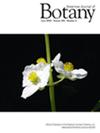Evaluating the combined effects of light and water availability on the early growth and physiology of Tamarindus indica: Implications for restoration
Abstract
Premise
The tamarind tree (Tamarindus indica) is a species of significant cultural, economic, and ecological value, with a pantropical distribution. However, the tamarind is experiencing a decline in wild populations in its native range, but the reasons for its decline remain unknown.
Methods
We examined the critical early life-history stages for tamarind establishment to understand how varying levels of light and water availability and watering frequency affect its regeneration. Through three greenhouse experiments, we assessed the impact of these resources on the germination, survival, growth, and physiological responses of tamarind seedlings and saplings.
Results
Water availability was critical for seed germination, but not light levels or pre-germination treatments. Light was the primary limiting factor for seedling growth. Tamarinds in high light availability grew taller, had more biomass and larger diameter, but the effect of light was modulated by water availability, indicating that there was an interaction between both resources. Water and light affected specific leaf area and leaf dry matter content but not biomass allocation, root-to-shoot ratio, or stomatal conductance. Water availability influenced sapling growth, but watering frequency did not, indicating a resilience of tamarind saplings to changes in rainfall periodicity but a sensitivity to total rainfall amounts.
Conclusions
Our study underscores the importance of considering both light and water availability in tamarind restoration efforts and contribute to understanding plant responses and trade-offs under different levels of critical resources. Our findings will inform conservation strategies to support the regeneration and long-term survival of Tamarindus indica in its native habitats.


 求助内容:
求助内容: 应助结果提醒方式:
应助结果提醒方式:


